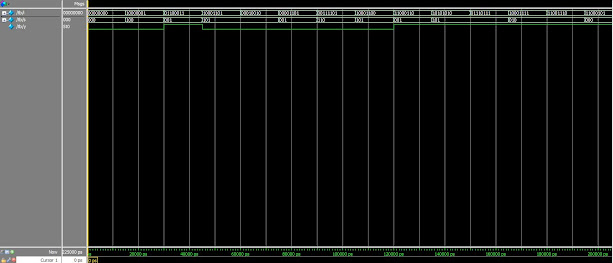EXPLANATION:
A multiplexer or in short mux is a combinational logic circuit used to pass only one of the multiple inputs(i0,i1,i2,i3,i4,i5,i6,i7) at a time with the help of select lines(s0,s1,s2) to generate the output(y).
A 8x1(Four cross one) mux has Eight inputs and 1 output. The output of a mux will always be one. The general formulae for all types of multiplexers is, For 2n inputs, the number of selects line will be n.
For 8x1 mux when s=000, the input line i0 will be transferred to the output y; when s=001, the input line i1 will be transferred to the output y; when s=010, the input line i2 will be transferred to the output y; when s=011, the input line i3 will be transferred to the output y and so on.
Verilog code:
module mux8_1(i,s,y);
input [7:0]i;
input [2:0]s;
output reg y;
always @(i,s)
y= (~s[2])&(~s[1])&(~s[0])&i[0]|(~s[2])&(~s[1])&(s[0])&i[1]|(~s[2])&(s[1])&(~s[0])&i[2]|(~s[2])&(s[1])&(s[0])&i[3]|(s[2])&(~s[1])&(~s[0])&i[4]|(s[2])&(~s[1])&(s[0])&i[5]|(s[2])&(s[1])&(~s[0])&i[6]|(s[2])&(s[1])&(s[0])&i[7];
endmodule
Test Bench:
`timescale 1ns/1ns
module tb;
reg[7:0]i;
reg [2:0]s;
wire y;
mux8_1 DUT(i,s,y);
initial
begin
s=3'b000;i=8'b00000000;
#15 s=$random ;i=$random;
#15 s=$random ;i=$random;
#15 s=$random ;i=$random;
#15 s=$random ;i=$random;
#15 s=$random ;i=$random;
#15 s=$random ;i=$random;
#15 s=$random ;i=$random;
#15 s=$random ;i=$random;
#15 s=$random ;i=$random;
#15 s=$random ;i=$random;
#15 s=$random ;i=$random;
#15 s=$random ;i=$random;
#15 s=$random ;i=$random;
#15 s=$random ;i=$random;
#15 s=$random ;i=$random;
end
endmodule
WAVEFORM:
Cheers to you all..




0 Comments
If you have any doubts , please let me know
Emoji